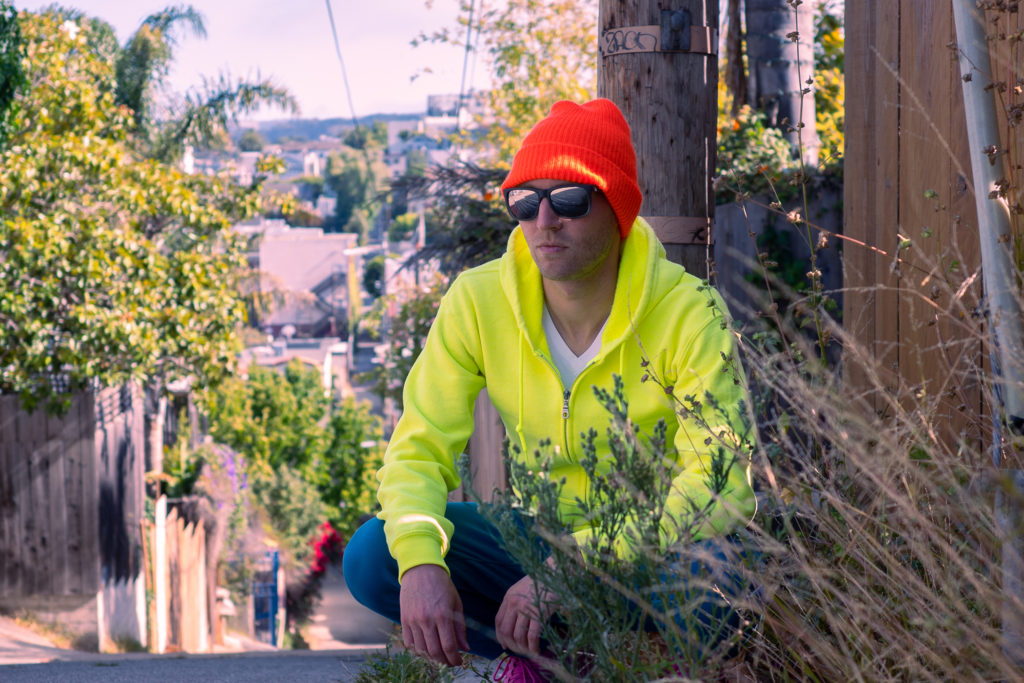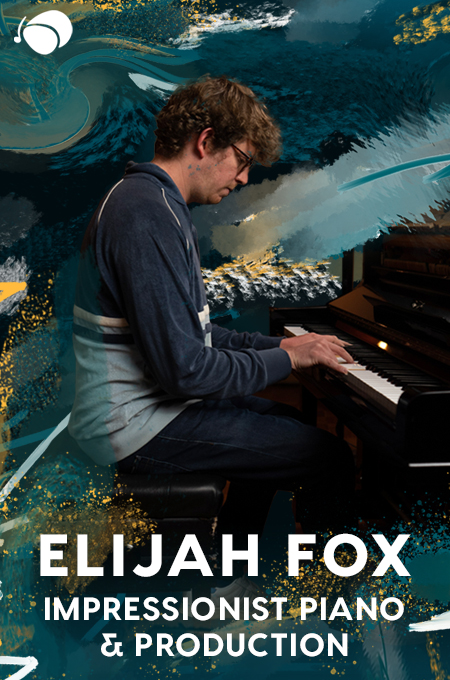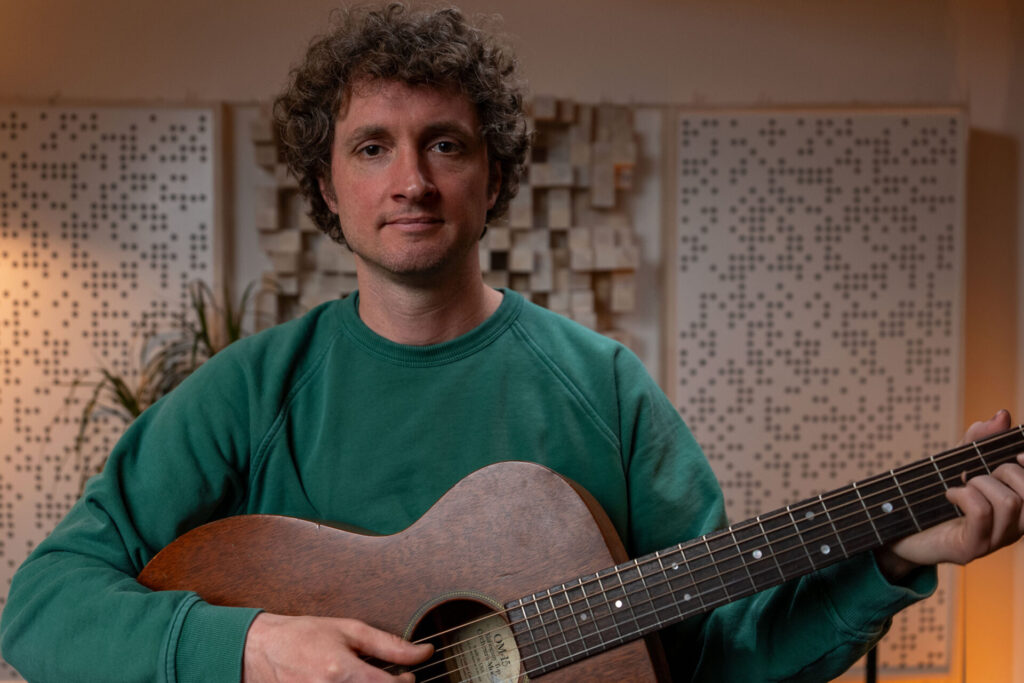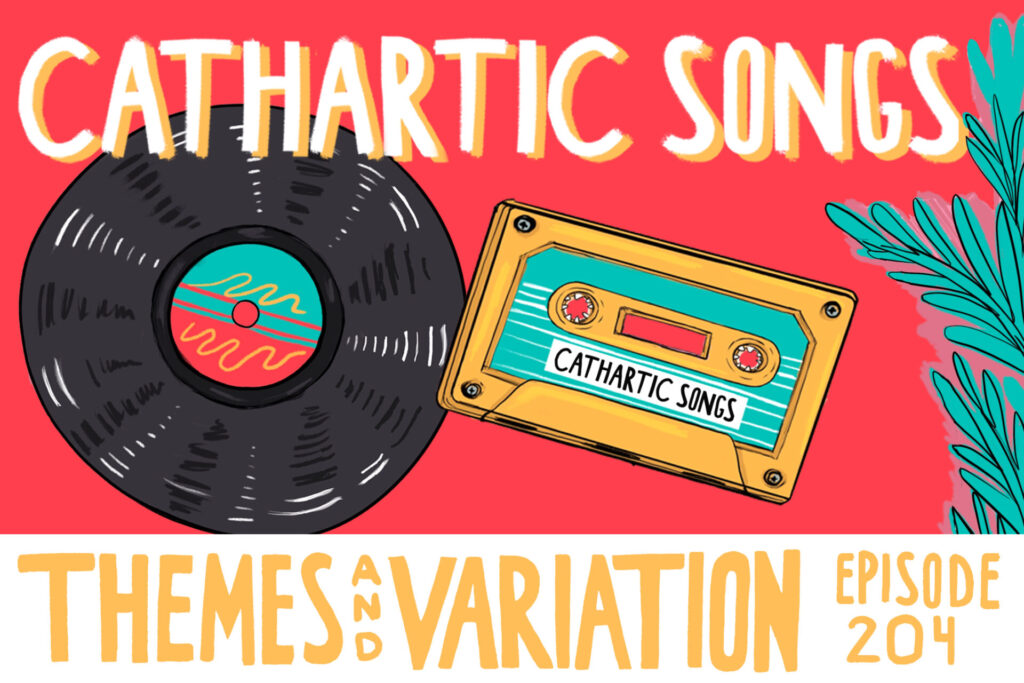
I guess you could call Marc Haumann’s self-dubbed genre “Dread Pop” a weightier, angstier take on the more common “Dream Pop.” With clear songwriting influences coming from Beirut, Radiohead, and Death Cab for Cutie, mixed together in a cocktail of emotion with musical and sonic cues courtesy of Sigur Rós, Max Richter, and Brian Eno, I can definitely see where this genre name came from!
But Haumann’s project Lemonglow doesn’t itself get weighed down by the emotive dread that informs his songwriting; no, instead it’s as if he takes all that there is to worry about these days (the environment, the economy, technology, mental health, you name it), and chops it all up into tiny pieces of confetti to then toss up in the air in a colorful, dare-I-say “joyful” aerial display.
Haumann arrived here to Soundfly this year to learn how to better balance and transmit his lofty musical ambitions in a cohesive, concise sound. And with his debut release, the Get Alive EP, out now, I think he’s achieved all that and much, much more. Take a listen:
Enjoy my recent conversation with Marc Haumann about his Lemonglow project and the experience he’s had working through several of Soundfly’s courses. Enjoy!
Q: You recently released your debut EP, Get Alive. Congrats! It’s a beautiful collection of emotive songs that span indie folk and modern electronic, ambient pop, cleanly produced and mixed. What’s the overall vision tying these tracks together?
A: Glad you enjoyed it! I strive for serious contemplation and emotion when I make music, so this is a collection of tracks that, although they have some pleasant tones and abstract lyrics, are grappling with heavy feelings. I wanted them to sound pretty together — poppy, even, but betray darker undercurrents.
In other words, “existential dread” is a major theme here.
You take a soft, tonal approach to vocal delivery, with lyrics rolled in abstraction but grounded in story. Speaking of those stories, what are the themes you’re trying to bring out lyrically in your music?
Lyrics are always a challenge for me. I often start with the melodies and notes, and evolve lyrics afterward. I typically sing in gibberish while I’m finding the melody, not worrying about conveying meaning so much as emotion. Occasionally words form in random moments, but mostly they’re just incoherent utterances (Sigur Rós’s Jónsi calls it “hopelandic”).
Once I’ve found the melody, I use the few real words I did express as anchor points from which to build, often in combination with a concept I choose to help guide the overall story. So naturally the lyrics tend to be abstract. The exceptions to this approach were for “American Dream” and “Get Alive,” which came out of an exercise of writing down key words elicited by a series of images.
For instance, the lyric “a hug of hair in black and white upon the river, perched in setting light” was a literal description of a photo I took of a friend back in college, hugging herself while sitting along the Providence River at sunset. From this, and a few other images, I tried to build up a sense of existential dread and this idea of searching for meaning, searching for oneself but never truly being able to find what you’re looking for or feel satisfied with your life.
I think dread really became the theme of the album, in different forms. Dread about the end of our world as we understand it; dread about the climate crisis (“The Flood”); dread about the dysfunction of our urban design and sprawling, resource-consuming lifestyle (“American Dream”); dread about making irrevocable mistakes (“Marrow”). Can I call my personal genre “Dread Pop?” 😆
I carried this concept of dread into the album artwork too, which I “co-created” with an A.I. app called “Dream” that generates imagery from text and image inputs. I fed the algorithm a photo I took myself as well as some of my own words and it transformed them into something new. I’m fascinated by how this technology has advanced so rapidly. It brings into question the idea of the artist’s worth and purpose, particularly when machines can now compete so well for such deeply creative acts.
What is your songwriting/production process like exactly? What elements do you start with and how do you build your tracks?
The DNA of my music is my voice; it’s the first “instrument” I ever learned to play. I capture voice memos anytime I’m out and about. Otherwise I’m sitting at my keyboard or with my ukulele and plucking out chords until I find something intriguing. I then re-record what I’ve learned, adding gibberish vocal exploration on top, all while capturing everything in Ableton Live. I typically add percussion and other instruments last, but I flipped my process upside down for the title track “Get Alive” to push myself out of my comfort zone. For that, I started with the percussion, which is likely why it’s the most beat-friendly track on the album.
I find it helpful to take lots of time for “sonic digestion” where I’ll export a bounce of the work-in-progress, go on a walk, and listen to the track, taking notes when it makes sense. I like to get a feel for how the song exists in the context of real life, and with a different set of ‘phones like my AirPods. This helps me calibrate balance, volume, overall tone, if there’s too much clutter or too little going on in places, and whether or not the essence of the song is coming through clearly.
Since college I’ve collected field recordings and voice memos of sounds and environments (the mic I used to record my vocals is actually a Zoom H2 field recorder). I was hoping to infuse this album with a lot of these found sounds, but discovered things got a little messy, so I’ve kept that pretty constrained but may explore it more deeply with my other ambient work. I did manage to inject it into the end of the album on the last track, “Marrow,” and snuck in some chimes from my neighbor’s backyard on “Get Alive.”
If I’m feeling stuck on a track, I’ll set it aside for a few days and work on a different song to get some fresh air and fresh perspective. Sometimes I force myself to push through that feeling and attempt to get to some kind of resolution, but that’s so much easier said than done. Holding the discipline to finish a piece is one of the most difficult aspects of making music for me.
“Holding the discipline to finish a piece is one of the most difficult aspects of making music for me.”
Do you have a favorite “go to” thing that you always use in your production?
My coveted baby is my Fatar Studio 1176 controller keyboard I got off Craigslist back in 2011. It has excellent weighted keys that deftly mimic playing a real piano, so I feel a bit spoiled whenever I play other keyboards without good quality weighted action. Piano is central to most of the music I write, and that’s reflected on this album. I still tweak the digital instrumentation as I find different piano flavors have different effects. I typically prefer the rich texture of upright pianos, but for some tracks, like “The Flood,” the cleaner grand piano sound felt more appropriate.
I have been fascinated by binaural audio for many years as well, so I try to pay attention to a song’s “width,” the panning and left/right balance, as I’m refining my mixes. I became transfixed by ASMR videos when they first appeared, so I’m hyper-aware of those spatial qualities whenever I’m listening to any stereo track. I try to be intentional about single vs double-tracking my vocals.
It’s been a process (and I’m still learning!) to iron out where those dynamics need to happen within the shape of the songs so they have the right feel and impact.

How did you arrive at this sound?
Going waaaayyyy back to elementary school, I took piano lessons, but I wasn’t really into the songs I was learning, and quit after just a year. In middle school, I joined the choir and also did “jazz choir” where we sang and danced, and had to get to school at 7:30am for rehearsals! In high school, I focused more on visual art over music, but I scratched the music itch by performing in a few musicals. In terms of listening, I found myself strangely drawn to polar opposite genres — the alt rock of Linkin Park, System of a Down, and… the ambient music of Hammock, Brian Eno, and later Max Richter.
In college, I re-visited piano, inspired by my discovery of Radiohead. I was so enthralled with Thom Yorke’s vocals and ballads, and I made it my mission to learn covers of as much of his work as I could. Luckily, there were pianos scattered across my school’s campus. To avoid attracting attention I’d sneak in to play them in the wee hours of the morning after (mostly) everyone had gone to sleep. Sometimes I’d pull all-nighters just playing and singing, attempting to learn all his work by ear, since I have never had formal music or sight-reading training.
Concurrently, I started exploring songwriting and recording/producing for my own work, and for collabs with a friend. I have continued developing my process since. I’m in the boat that I’m sure many creatives are in, which is having a huge library of song “seeds” but very few fleshed-out pieces. Taking a recent workshop and doing Soundfly courses really helped me push through the creative slump and complete the tracks that have made it onto this album, along with a few more that I’ll hopefully include on more releases in the future.
Who are your biggest inspirations in terms of songwriters or producers, and why?
My biggest inspiration is Radiohead, from OK Computer onward. I gravitated to the way they pushed their own boundaries to produce novel soundscapes with each album, while still keeping so much familiar grounding, especially in their ballads. I’m a huge fan of Death Cab for Cutie and The Postal Service, for their lush melodies and intricate lyrics. And from a pop angle, Sylvan Esso is at the top of my list. They’ve got a glitch-dance twist that draws the listener in with fresh and unexpected textures.
I adore Sigur Rós, particularly their untitled album, ( ), in full hopelandic which feels like a merger of my early musical interests. The emotions there are so pure and raw, particularly since you’re not allowed to get pulled into meaning through intelligible lyrics. It focuses the listener on feelings and vocal delivery, it’s a wholly right-brain experience that I love.
Beirut is another top influence, and a band I’ve covered with friends busking on the streets of San Francisco, Paris, New York, and Berlin. I find myself able to emulate Zach Condon’s voice decently well, which may be why I initially gravitated to his music; it felt natural and joyful to sing his songs. You might hear nods to his instrumentation in the ukulele-forward track “American Dream.” And then of course there’s Beach House, whose excellent song I stole to name this band 😏.
What brought you to Soundfly originally?
My boyfriend was listening to Soundfly’s podcast, Themes and Variation, and heard about the courses, so he sent them my way! He’s got a great ear and I really value his taste, so he’s been a helpful resource for discovering new music and music learning opportunities!
Which of Soundfly’s courses have you taken and which has been your favorite so far?
I’m working through Advanced Synths and Patch Design for Producers, which has helped me fine-tune my instruments and effects on this album, and I’m excited to apply the learnings more fully on upcoming projects. I’m also taking the Faders Up mixing courses to dive deeper into mixing, panning, compression, and automation. I have a rudimentary knowledge about those topics, but the courses are helping me level up.
Kimbra’s course on vocals has been killer, definitely my favorite one so far. I love the metaphors she uses to describe her work and process, and how she speaks so eloquently about her work and multifaceted approaches. It’s such a privilege to get that kind of insight into her world and her brain, and just plain fun to watch her work her magic! I took her video on backing vocals to heart. Especially how she describes different frequency ranges as having different “colors,” like soft shimmers at the high range with breathier tones, and heavier solid sounds in the low ranges. I used that inspiration to work multiple vocal layers into the ending build of “The Flood,” and I also applied her call-response concept in that same section.
What’s next for you in 2022? What are you working on now?
I’ve got a few more solo tracks in the works, in addition to the album I’m making with my friend from college. It’s been 10 years since we began writing those songs together, but are making progress on the arrangements with the goal of getting everything more robustly recorded and produced.
I also have a set of ambient tracks that I’d love to release under a separate project, so stay tuned for that!
Don’t stop here!
Continue learning with hundreds of lessons on songwriting, mixing, recording and production, composing, beat making, and more on Soundfly, with in-depth artist-led courses by RJD2, Kimbra, Ryan Lott, Com Truise, and the acclaimed Jlin: Rhythm, Variation, & Vulnerability.



